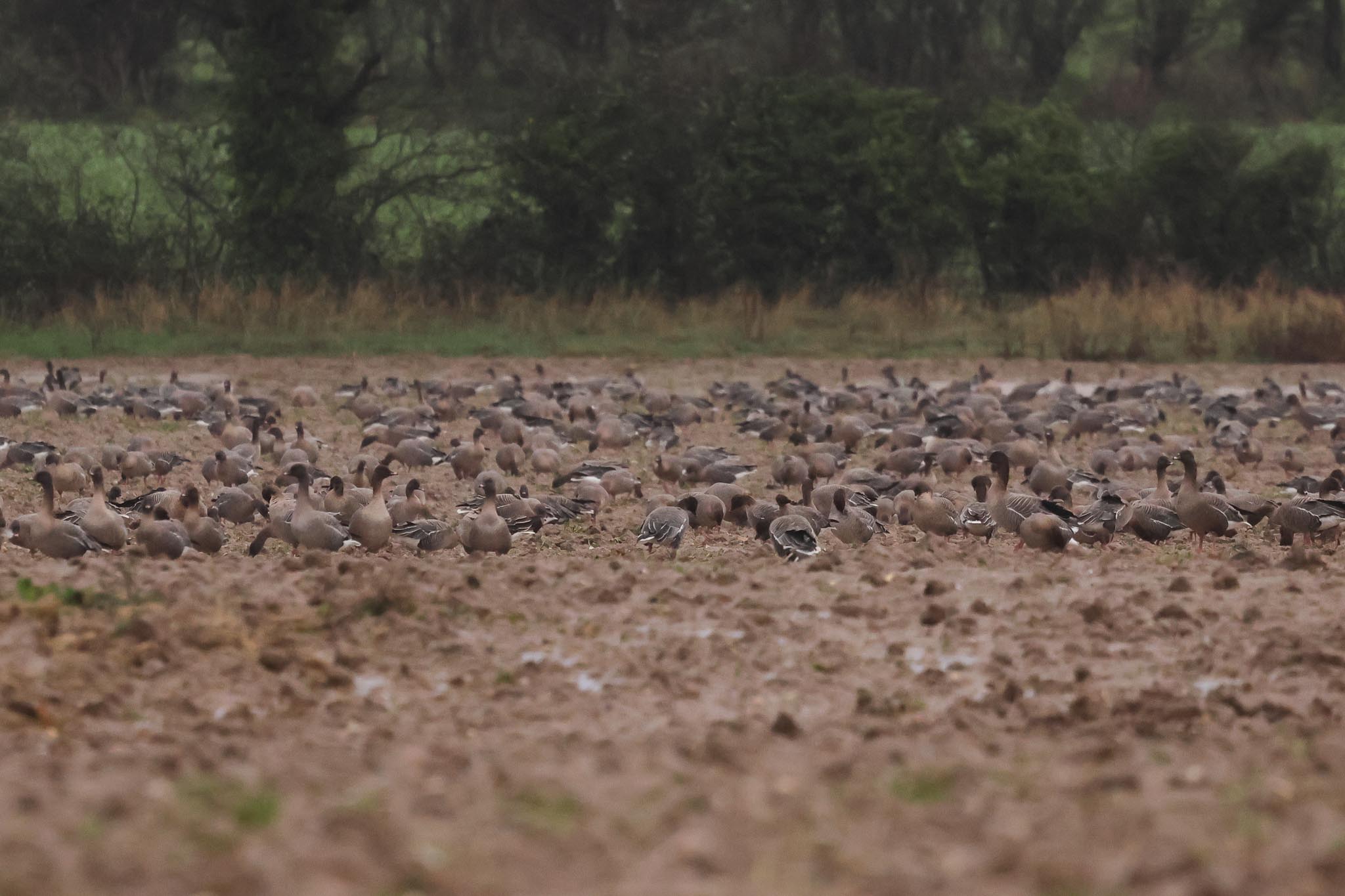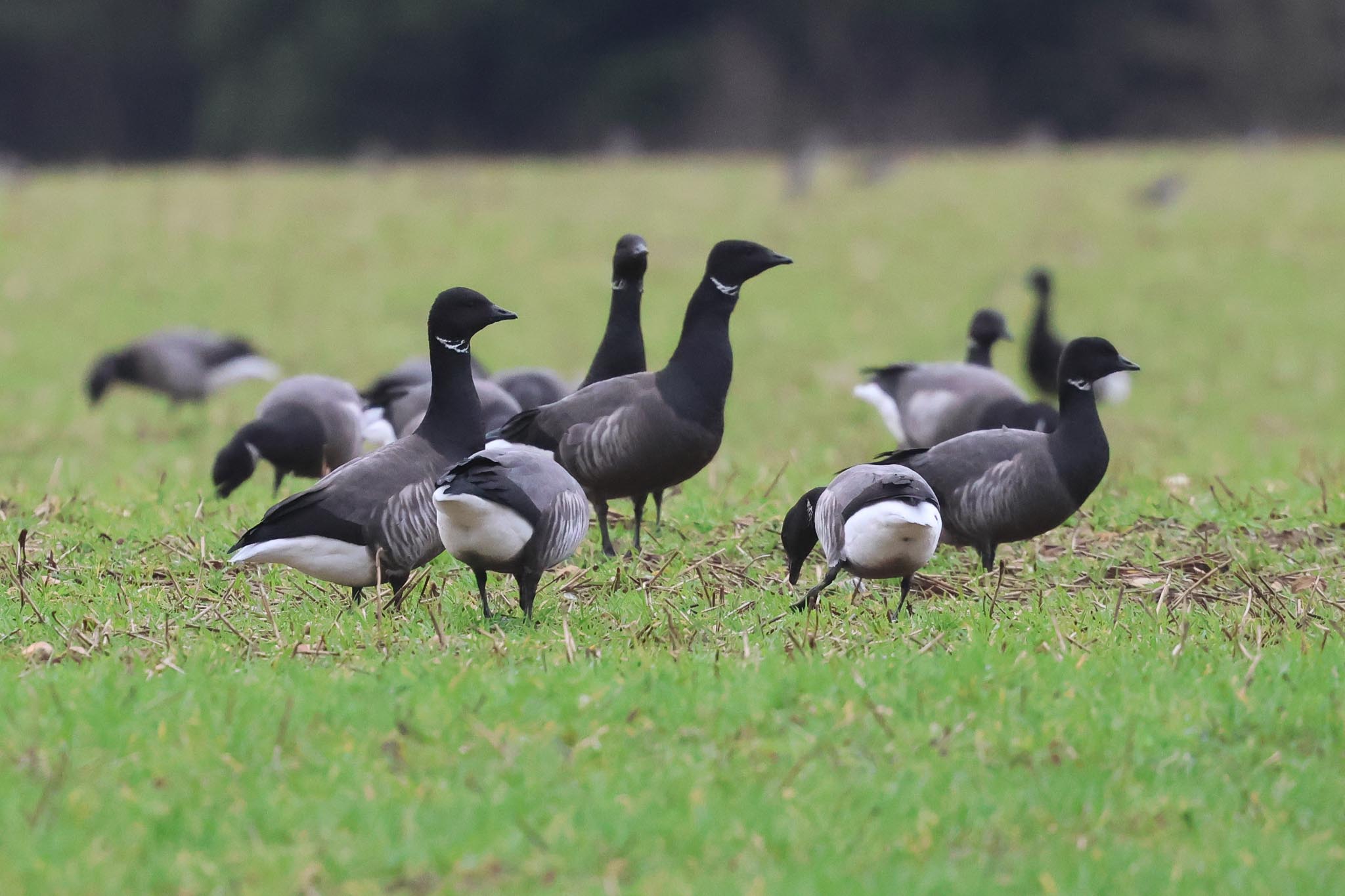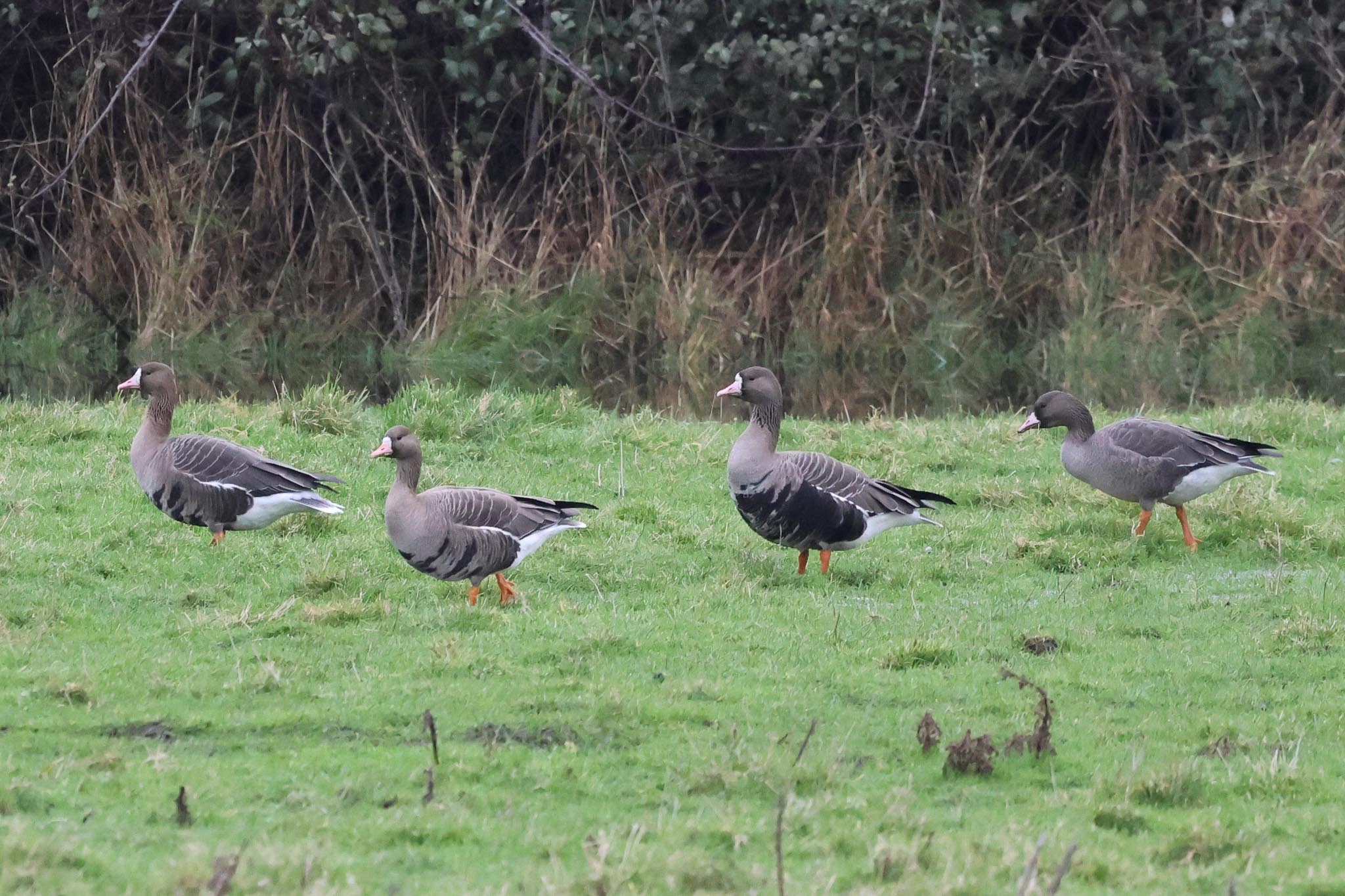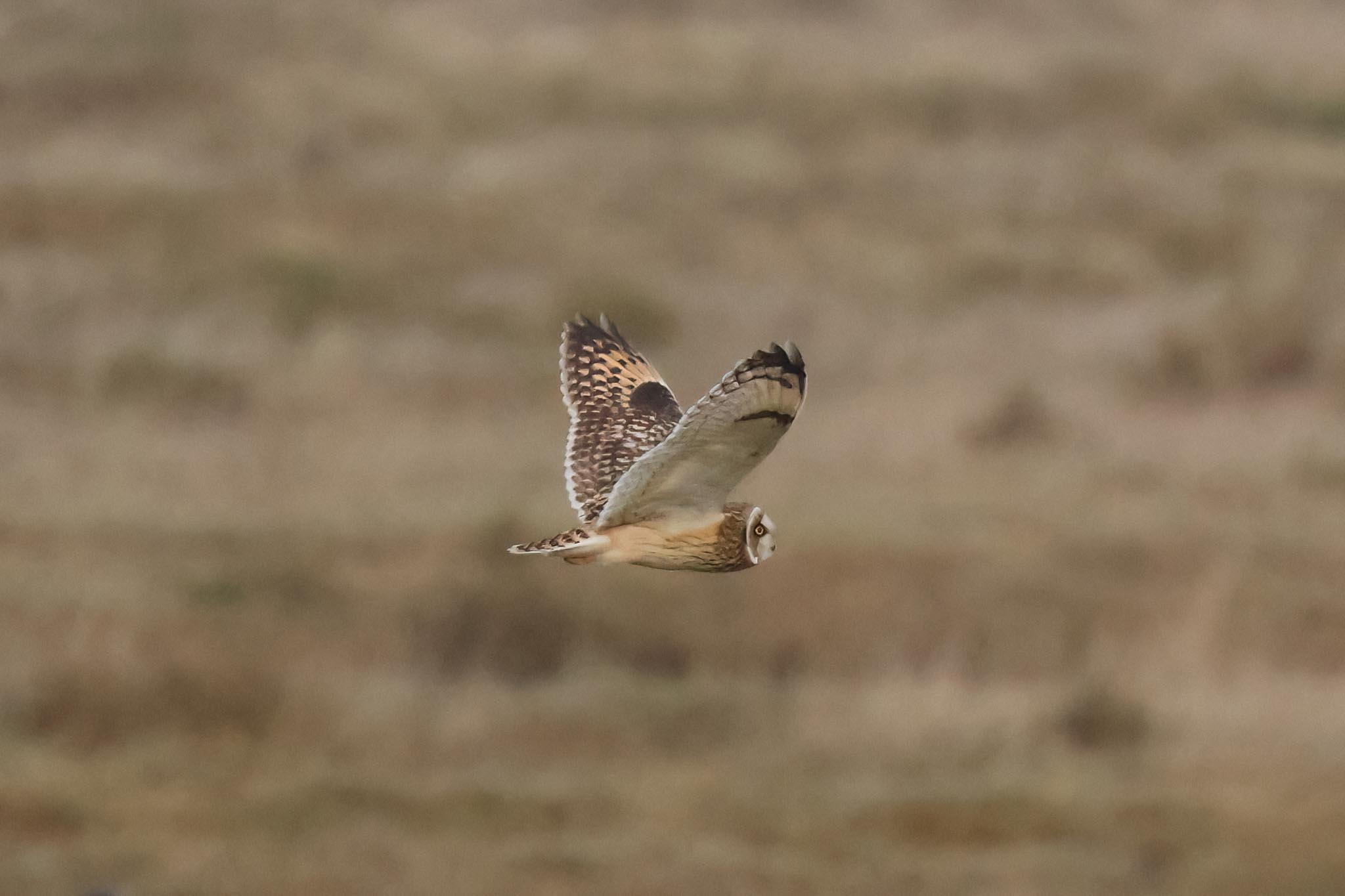Day 1 of a 3-day Winter & Owls Tour. The forecast a couple of days ago was for some nice crisp winter weather, light winds and high pressure, over the weekend, but that had changed and now we had yet more heavy rain overnight which at least cleared through early this morning. We were left with a rather grey and damp day with a more blustery NNW wind than we had been expecting. We made the best of it, even if the birds didn’t all play ball.
On our way up to the coast, we stopped to look at a large flock of geese feeding in a recently harvested sugar beet field. From a distance, it almost looked like there wasn’t anything there, as the geese were the same colour as the mud, but once we got out of the minibus (the geese were far enough away that we wouldn’t disturb them) we could see the back of the field was completely covered in Pink-footed Geese.

We set up the scope and scanned through the flock. There were quite a few Greylag Geese in the other geese, perhaps true wild Icelandic birds which had travelled down here with the Pinkfeet. We picked up a pair of Russian White-fronted Geese too, hard to see in the middle of the flock until they lifted their heads and you could see the white blaze around the base of their bills. A juvenile White-fronted Goose was with them, presumably a small family party.
Several Skylarks flew up occasionally from the field too, and a few Pied Wagtails were feeding out on the mud. There were quite a few Lapwings in here as well, and four Golden Plover flew in and looked like they were going to join them but then didn’t land and flew off again.
We had managed to stay out of the worst of the rain, in the lee of the minibus, and it now seemed to be stopping. We moved on, and went to look for our regular Tawny Owl. As we walked in along the footpath, a few Chaffinches flew up from the hedge and a Robin flicked ahead of us. When we got almost to where we could view the tree, we slowed down and walked on quietly until we could look back and see the hole. The Tawny Owl was there, at the entrance, but before we could even get everyone on the hole it dropped down inside, out of view. Sometimes it can sit out in full view and doesn’t seem to care and other times it disappears instantly – unfortunately, today was one of the latter.
Nothing else for it, we would have to try again another time. As we walked back towards the minibus, a flock Long-tailed Tits appeared in the trees by the path. We stopped to look and a Treecreeper was singing further in, followed by a Coal Tit too. It didn’t feel like it much today, but spring is coming – hopefully, eventually! A Nuthatch flew out onto the edge of the wood too briefly and perched in the top of a tree, before disappearing back in. Back towards the road, three Greenfinches flew up out of the hedge calling.
The Red-breasted Goose had been reported in the Eye Field at Cley earlier, and has spent most of the last few days feeding there with the Brent Goose flock, so we headed down to look for that next. As we passed the grazing marshes just before the village, a Great White Egret was standing out in the wet grass. But as we drove down Beach Road, there was no sign of any geese on Cricket Marsh or in the Eye Field now. Some locals already in the beach car park hadn’t seen any geese either, so we decided to have a look in some fields inland where it has been on other occasions.
Initially we couldn’t find any geese at all up the Glaven Valley, although we did come across at least 20 Ruff feeding in some pig fields by the road, with some Lapwings. When we got as far as Holt, we checked one field just south of town, but there was nothing there either, so we came back down the Cley Road. Here we did find the large flock of Brent Geese feeding in some winter wheat. Again, we got out very carefully and gradually, by changing angles, managed to check through the whole flock, but to our disappointment, the Red-breasted Goose was not with them today.

While we had a quick break to use the facilities in the Visitor Centre at Cley, we scanned the marshes. There was still no sign of any Brent Geese, although there were about a dozen Brents in the field behind. There is a lot of water on the scrapes after all the recent rain and there seemed to be few birds out there today, so we decided to try our luck elsewhere. The Shorelarks which usually winter at Holkham have been very elusive recently, so with a message from someone we know to say they were back in the cordon, we thought we might try our luck.
We diverted inland off the coast road at Wiveton and found lots of egrets in one of the wet grazing meadows. There have been some Cattle Egrets here on and off in recent weeks, and sure enough we found three of them now, in with several Little Egrets. One of the Cattle Egrets had a little bit of breeding plumage, a light wash of orange on its head and back. Two Bullfinches flicked ahead of us in and out of the hedge as we found somewhere to pull in and got out to look at the egrets.

Moving on west, the grazing marshes just east of Stiffkey were almost completely under water and the ones the other side of the village were not much better. We pulled up opposite the Red Lion and expected there to be no sign of the Glossy Ibis but there it was, feeding on the grass the other side of the water. We managed to pull mostly off the road and got out to get the scopes on it. It was not much bigger than the Curlews it was feeding with. There were lots of Wigeon and a few Teal around the edges of the water too.

When we got to Holkham, knowing that the Shorelarks have not lingered in the cordon long in recent days, we headed straight out towards the beach. We hadn’t got far beyond the boardwalk when we met someone coming back who told us they had flown off west half an hour earlier, so we walked up to the top of the dunes, on the edge of the pines, to look across to the Gap. We had only just started scanning when we picked up the fourteen Shorelarks flying round the dunes and out onto the beach out of view.
As we didn’t want to get wet feet for those not wearing wellies, we walked down to the cordon and cut across to the beach on the path there. We couldn’t see anything out on the sand from here, so we walked west on the beach towards the Gap, but we hadn’t quite got there when we spotted the Shorelarks flying out towards the sea further up. They flew up and down over the beach a couple of times, and at one point looked like they might be coming back towards us, but then they turned and headed away along the shoreline. Eventually we lost sight of them as they disappeared off west. At least we had seen them, though not the views we had hoped for.
There were lots of Common Scoter in a huge raft out on the sea, but it was very rough out there today, with the blustery onshore wind. We turned the scopes on them, so that everyone could at least see the flock. There have been up to 20 Velvet Scoter with them, but they were going to be impossible to pick out on the water in these conditions. Then two Velvet Scoter flew in over the Commons, so that we could see the white in their wings, flying round a couple of times before dropping back down on the sea.
There were several silvery grey Sanderling running up and down on the shore and a couple of Oystercatchers flew in and landed on the beach too. We walked back round via the cordon, and the drier path. A large group of Shelduck was out on the saltmarsh but there was no sign of any other small birds out here today – it had probably been too disturbed over the festive period. When we got back to the Lookout, it was time for lunch.

We looked for the Grey Partridges by Lady Anne’s Drive, before and after lunch, but once again this winter there was no sign of them. There were lots of ducks out on the grazing marshes – Wigeon, Teal and a few Shoveler – and when a Marsh Harrier drifted over, they all took to the air and whirled round. A couple of Red Kites were hanging in the breeze either side of the Drive and a distant Common Buzzard perched on a bush. A Sparrowhawk flew over the cafe while we were eating.
There is a lot of water on the grazing marshes here, and as we drove back up the Drive towards the main road, we stopped to look at the gulls feeding in the wet grass. There were several Common Gulls in with the Black-headed Gulls.
We turned right onto the A149 and as we drove west alongside the park, we could see White-fronted Geese on one of the fields next to the road. There were several cars in the layby, but one was pulling out, so we turned around further up and just about pulled off the road so we could get out for a quick look. There were at least 55 White-fronted Geese here when we arrived, closer and better views than this morning, not hidden in a mass of Pinkfeet. We could see the different patterns of black belly bars between the individuals and the pinkish bills, one of the main features which mark them out as Russian White-fronted Geese. Small groups started to fly up and off west, calling as they went.

There were three Barnacle Geese here too, and one of them was sporting a yellow colour-ring. There is a feral breeding population in Holkham Park and this bird had been apparently ringed there in summer 2022. It seems to commute down to Suffolk for the early part of the winter, and it was a bit of a surprise to see that it was back here so early (although it was seen back here by mid Feb 2023).
We planned to finish the day at Warham Greens but we had timed our arrival around the best period for the Pallid Harrier – we had not wanted to get there too early as it might be chilly standing around too long in the wind. As we made our way over there now, a pair of Grey Partridge flew over the road in front of us.
Down on the edge of the saltmarsh, there were a few local birders already looking. We had missed a couple of Hen Harriers apparently, but there had been no sign of the Pallid Harrier coming in to roost yet. We joined them and started to scan ourselves. Whether it was the cold wind or the odd drizzly shower which blew in, it quickly became apparent that there wasn’t much activity here tonight. We saw a couple of brief Marsh Harriers up, but no further sign of the Hens (which had maybe gone in to roost already) and we couldn’t find any Merlin either. The peak period for the Pallid Harrier to come in came and went without any sign of it.
Some of the others were just leaving when we picked up a Short-eared Owl flying towards us over the near edge of the saltmarsh. We shouted and they turned back round. The Short-eared Owl looked like it might come across right in front of us, but went to land, changed its mind, and turned and headed back off the other way. A nice consolation prize.

The light was starting to go now, not helped by it being very overcast, and if anything flew in we would not have very good views, so we decided to call it a night. As we walked back up the track, the flocks of Brent Geese were flying in over the fields and out over the saltmarsh to roost. We could hear them chattering as they passed. Hopefully the weather would be better tomorrow.
















